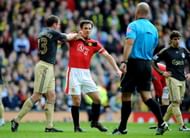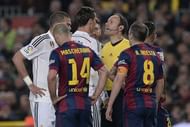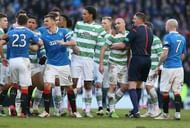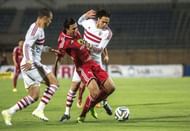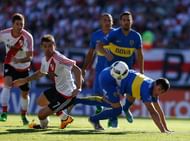Irrespective of the football league you follow, there are those fixtures of the league calendar which mean more than just a weekend game. As bitter rivals clash, football matches transcend to a state of war.
Adrenaline runs through the veins of players. Fans, in their anxious wait for the bragging rights, go through a series of emotions ranging from ecstasy to misery.
Here I talk about those rivalries that started somewhere beyond football and are re-ignited in the confinements of a football pitch every year. These are the clashes even a layman will look forward to, for a victory has implications bigger than three points.
Let us take a look at football rivalries that run deeper than football:
1) Manchester United vs Liverpool
The late 18th century marked the beginning of the industrial era in England. It also gave birth to a fascinating tale of rivalry between two cities separated by 30 miles.
Manchester and Liverpool, the heart of North West England, competed for industrial supremacy. Manchester was famous for its prowess in the manufacturing sector and Liverpool for its port.
The industrial revolution paved the way for a textile boom. Cotton mills of Manchester captured the trade and the city flourished. Liverpool, on the other hand, was the economic capital of north-west and had one of the best ports of the world. This created jobs for many.
So far so good.
However, the businessmen of Manchester grew frustrated by the charges placed on them by Liverpool's docks. The Mancunian merchants were forced to pay heavy duties for importing the raw materials required for their mills.
In 1894, Manchester built the ship canal that enabled them to directly bring the goods to the city without having to pay the import charges.This changed the entire dynamics of the economy in the north-west. Liverpool experienced a massive slump and people started losing jobs.
Merseysiders started hating the Mancunians.
As years passed, the rivalry only got bitter and bitter. It extended to several fields including music. Comparisons were inevitable. If it was the Liverpudlian Beatles that captured the imagination of the youth in the 60s, it was the Mancunian bands of The Stone Roses and Oasis that stole the show in 80s and 90s. But that one field which portrays the rivalry to the fullest is football. Every year the cities go to war mode as Manchester United F.C take on Liverpool F.C.
The cities of Liverpool and Manchester were, are and will continue to be the pride of North West England.These are the cities which give the North west a leverage over London. As far as the political scenario is concerned, the feelings have, in the view of mutual benefit, softened. But the football rivalry remains intense.
2) Real Madrid vs Barcelona
The El Clasico as we know it today is arguably the most widely followed football match. However, beyond the dimensions of football, beyond the question of "Who is better: Messi or Ronaldo" , is the 300-year-old turbulent history of the two big cities of Madrid and Barcelona.
The elite class of Madrid were the proponents of conservatism. The separatists of Barcelona, on the other hand, firmly believed in liberalism .Politically speaking, poles apart.
Barcelona is the capital of Catalonia- an independence-seeking region which stands out as one of the richest and most industrialised territories of Spain. Over three centuries ago, Catalonia was proclaimed as a free state and they started enjoying cultural, lingual and political freedom.
But a civil unrest followed within a couple of years and Catalonia lost its sovereignty. The reign of dictator Franco rubbed salt into the wound of Catalans. In 1936, Spanish military leaders ordered for what followed to be one of the biggest tragedies in the turbulent Spanish history: the Spanish civil war.
The right-wing proponent General Franco emerged victorious and he hurt the Catalans by banning the use of Catalan language arguing it was a threat to the sovereignty of the nation.
Gradually, football grew as a medium for the Catalans to vent out the frustration and sentiments. The Catalans, irrespective of whether they followed the game or not, started supporting FC Barcelona. The Catalans celebrated their cultural extravagance through football. Barcelona became "mes que un club" which translates to 'more than just a club'.
The club started receiving admiration not just from the Catalonian separatists but also from the left ideologists. General Franco used Real Madrid as a weapon to suppress the tremors created by FC Barcelona. In the following four decades of Franco's rule, Real Madrid dominated the game and enjoyed unprecedented success as Catalan liberalists fought in vain.
However, after the death of General Franco, Catalonia attained cultural and lingual freedom. But the struggle for sovereignty still continues. Another argument being put forward by the separatists is that Barcelona contributes more to the wealth of nation than it receives back.
When Barcelona take on Real Madrid, they are not simply playing for a league title. They are fighting for independence. They are fighting for their identity.
As for Real Madrid, they are fighting for the unification of a nation which has been hurt by cultural and political stigma from time immemorial. They are fighting to inspire patriotism and silence the voice of the Catalan separatists.
3) Celtic vs Rangers
The Glasgow derby, otherwise called the Old Firm derby, is considered by many as the biggest and the most heated rivalry in football.
Some rivalries have social dimensions and some, political. But not many rivalries are as complex and have as many dimensions as the Old firm rivalry. Generally, the Old firm rivalry is considered to be centred around a religious dispute between the Catholics and Protestants with Rangers traditionally drawing support from Protestants and Celtics from Roman Catholics.
There is also a conflict of national identity with Celtics being Irish-Scots and Rangers, native scots. In the 19th century, Catholics from Ireland migrated to the city of Glasgow. This developed a sense of insecurity in the minds of local Protestants and they responded with hostility.
History is that the Irish immigrants felt oppressed by the local Scots. They simply couldn't integrate their community into the new country. As a solution to this problem, the Celtic Football club was founded in 1887. Primarily started with an aim of raising fund for charity, the Celtic football club became the face of Irish Catholics.
Opening entry to all religious faiths, Celtics quickly rose to popularity and became one of the most successful clubs in the country. The Scottish protestants desperately wanted a team of their own to fight the Celtics. Rangers, a club formed in 1872, emerged as the suitable option. From then onwards, the old firm derby has been nothing short of a war.
For Glasgow, football sometimes becomes the stage to demonstrate sectarianism and religious bigotry. The meetings of these two clubs often lead to violence. One notable incident is the riot that happened in 1980 during the Scottish Cup final which turned out to be one of the worst ever pitch invasions.
Nil by Mouth, an anti-sectarian charity organisation,is currently working to bring harmony among fans. Posters with anti- sectarian slogans are also being circulated to create awareness. Maybe with time people will commit to putting an end to the sectarian violence and maybe then we can hope for Old Firm derby to be a friendly game between two old firm friends- a fierce battle in the true spirits of the game.
4) Al-Ahly vs Zamalek
In Andy Mitten's book Mad for it, he says "Cairo boasts a footballing rivalry that can genuinely claim to dwarf Real v Barca and Boca v River Plate. Al-Ahly v Zamalek goes beyond fanatical. It is part football match, part political rally, part history lesson and generally a good excuse for the locals to hurl rocks at each other.”
The rivalry between Al-Ahly and Zamalek is something bigger than Egypt or even the entire Northern Africa. This is a match that is so intense that foreign referees are brought in to make the game look as unbiased as possible.
The Cairo derby was shaped by political factors that date back to the time of British rule in the country. Al-Ahly became a club associated with qualities of nationalism and pride and drew support from the working class.
Zamalek, in contrast, was backed by the elite, the intellectuals, the military and the administrative class. Simply put, it was Nationalists vs Royalists.
The very game that the British brought into the country eventually became the symbol of revolution. Under British rule, the local working class men were denied admission to societies. In 1905, an Egyptian lawyer founded the Students Club for people excluded from societies.
Within a couple of years, it became the Al-Ahly football club. The name translates to 'The National'. True to its name, the club was a platform for nationalist youth to revolt against the British. The patriotic working class gathered together in support of Al-Ahly.
In 1911 when Belgian lawyer George Marzbach founded Zamalek, the rivalry was born. Zamalek began as a sporting society and permitted entry to all nationalities, particularly the elite class. It was supported by the elite who started feeling insecure by the rising nationalism of Al-Ahly supporters.
The fact that Zamalek was the club of the widely hated King Farouk only intensified the rivalry with Al-Ahly.
The Cairo derby is fought on and off the pitch causing death and destruction. Even today, the Ahly supporters believe that the city belongs to them and that Zamalek supporters are half British. Today, fans of both sides have become more organised in the form of an 'Ultras' model, similar to that in Europe. Such is the extreme nature of this rivalry.
All that being said, Al-Ahly and Zamalek are blessings in disguise for Egypt. Both the clubs have heavily contributed to the success of the national team in African Cup of Nations.
When Egypt went onto to win a hattrick of titles from 2006 to 2010, majority of the best players of the country came from these two clubs. Maybe, this rivalry is perhaps the key to taking Egyptian football to big heights.
5) River Plater vs Boca Juniors
European football has never matched the flair and flamboyance of Latin American football. Latin Americans bring to us the game in its pristine and most beautiful form. For them football, be it played in the streets of Rosario or the Maracanã stadium of Rio di Janeiro, is the best medium for expression.
In Buenos Aires when River Plate go against Boca Juniors the entire nation witnesses one of the most expressive, vocal and historical rivalries in football- The Superclasico.The origin of the rivalry dates back to the early 20th century. River Plate and Boca Juniors were originally formed in La Boca, the working class dockland area of Buenos Aires, in 1901 and 1905 respectively.
Joel Richards, in his book Superclásico: Inside The Ultimate Derby, says “This derby is often pitched as the tale of two cities, the aristocratic River Plate from the north against the people's team, Boca Juniors, in the south. In fact, the rivalry started as a turf war in the port area of La Boca in Buenos Aires -- both were founded by the children of immigrants; both had difficulty finding land in the area for their ground; both chose to have some English in their name to add some perceived glamour to their club.
It started out as a local rivalry before it grew to be the battle to find out which is the biggest club in the country.”
In 1925, River moved to the prosperous district of Nunez in the north. River started generating an upper-class fan base and this gave them the nickname of Los Millonarios. Boca stayed behind and became the club of the working class.
The support came from the local Italian immigrant community. So they came to be known as Xeneizes (Genoese), a name which refers to Genoa of Italy. But now the club has fan base all over Argentina with more than 70% of the Argentine football fans believed to be either a Boca or a River supporter.
The Boca supporters hated River for the fact that they deserted La Boca for the riches. They started claiming La Boca belonged to them. They also started calling River as gallinas (chickens) for they believed River players and fans lacked courage.Though they initially belonged to La Boca, River retaliated to the abuses by referring to Boca as Los chanchitos (little pigs) because they claimed the area smelled bad.
Everytime Boca and River clash, it is a blend of class, tradition and football. It is a portrayal of the history and culture of the city of Buenos Aires. Cherished by likes of Diego Maradona, Juan Riquelme, Radamel Falcao and Carlos Tevez, this will always be a rivalry that has big place in the minds of great players.
